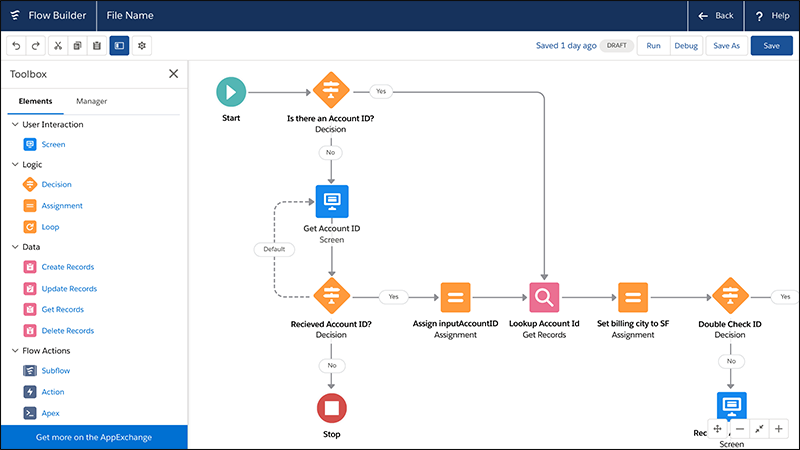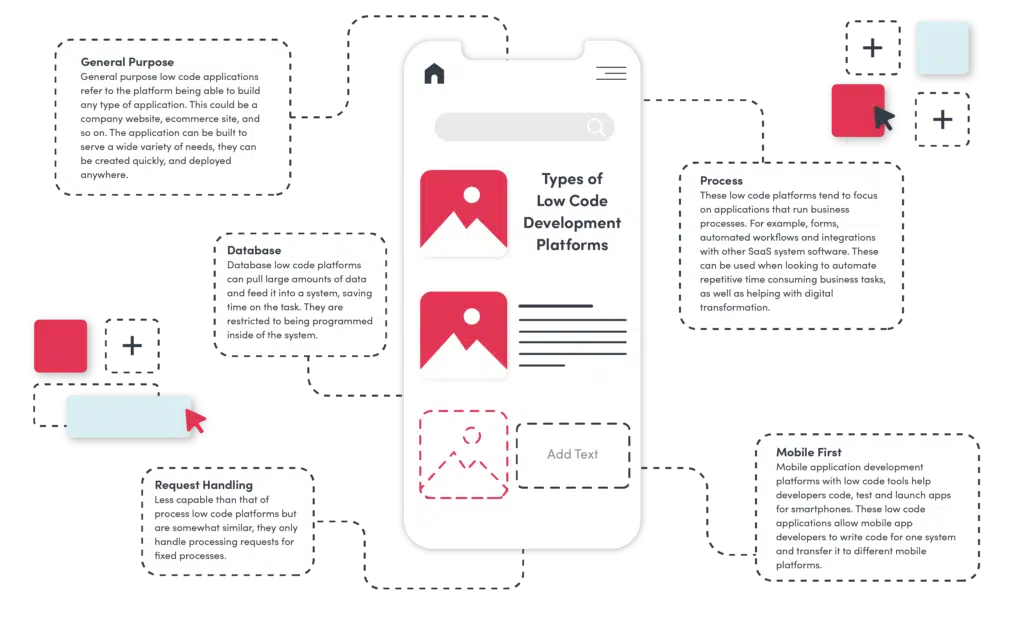Top Advice For Picking Low-Code Platform Info
Top Advice For Picking Low-Code Platform Info
Blog Article
The Advantages Of Developing Low-Code To Speed Up Development
Low-code application development significantly enhances the speed of development due to a variety of crucial factors. Development Environment:
Drag-and-Drop Interfaces: Low-code platforms provide visual tools for designing applications. Developers can easily build an application using drag-and-drop elements without having to write code.
Many low-code platforms have prebuilt templates and components. This lets developers quickly prototype or build applications, without having start from scratch.
Reduced Coding requirements:
Automated Generated Code: Lowcode platforms generate the underlying code, based on the visual models that developers have created. This eliminates manual coding and speeds the process of development.
Reusable Components : Developers can reuse components in different projects to reduce the amount of time they spend writing and testing codes.
Collaboration is streamlined:
Integrated Development Tools : Low code platforms usually include tools to test versions, deployment and version control. They aid in collaboration between teams.
Citizen Development (Citizen Development) Developers and users of business applications are able to participate in application development by using user-friendly interfaces. This helps to reduce the burden caused by a lack of accessibility of professional developers.
Rapid Iteration and Prototyping:
Rapid Prototyping Developers are able to quickly develop prototypes to allow ideas to be evaluated and feedback collected and analyzed, which leads to faster iterations.
Easy Modifications – The visual nature of low-code applications allows easy updates and changes, which speeds up the refining of applications based upon user feedback.
Pre-built Integrations:
API Integrations Low-code platforms have already built connectors that can be used with the most popular APIs or services. They cut down the time it takes to integrate external applications.
Data Integration: Built in tools for data-integration make it easier to connect databases and data sources. This accelerates development.
Scaling and Deployment:
One-Click deployment: A lot of platforms that make use of low-code have the option of deploying with one click applications, which can reduce the amount of time and effort.
Cloud-Based Solution: Cloud based low code platforms are able to handle the management of infrastructure and scale. This lets developers concentrate on applications' logic, functions and features instead of deployment logistics.
The primary benefit of low-code application development, in terms of speed, is its ability to automate and simplify a variety of aspects in the development process. This allows for quicker delivery of applications and more rapid adaptation to changing demands. Read the top Low-code Platform for application development for blog recommendations including rad application development, azure sql, push notifications, app modernisation, azure sql server, build a docker container, rapid application design, no code platforms, low code development platforms, develop cross platform mobile app and more.
Benefits Of Developing Applications Using Low-Code In Terms Of Scalability And Flexibility
Low-code applications offer several advantages when it comes to scalability. They are scalable and flexible, and they can be adapted to new requirements. Here are some of the key advantages.
Cloud-based deployment: A lot of low code platforms are cloud based. This lets applications expand seamlessly with cloud infrastructure. This allows businesses handle increased load without worrying about managing servers.
Auto-Scaling: The auto-scaling function allows you to automatically adjust resources according to demand. This ensures the same performance even during peak hours with no manual intervention.
Flexible Architecture:
Modular Design: Low-code systems promote modular design of applications, in which components can be developed independently as well as tested and scaled. Modularity increases flexibility and enables easier modifications or expansions to specific parts without impacting the whole system.
Microservices Integration Microservices Architecture support lets applications to be constructed as a set of loosely coupled services, enhancing both flexibility and scalability.
Customizable Solutions
Extensibility. Low-code platforms usually allow the creation of custom scripts or coding. Developers can expand the functionality of the application beyond what it comes with out of the package. It allows developers to meet their specific business requirements without any limitations.
Third-Party Integrations: Businesses are able to incorporate additional functions and features into their applications by integrating with APIs and third-party services.
Agile Development and deployment:
Continuous Delivery and Deployment Low-code platforms can be used to implement agile methods that allow continuous integration and continuous delivery (CI/CD). This allows for rapid deployment of updates and new features, while ensuring that the applications are able to evolve rapidly in response to feedback from users and market shifts.
Iterative Development: Because of the iterative nature, low-code applications can scale and grow incrementally. This reduces the risks associated with major changes and permits greater control over expansion.
Resource Optimization
Resource management that is efficient Low-code platforms maximize resources by supplying tools for monitoring and controlling the performance of the application. This allows resources to be utilized efficiently and also to be sized up or down based on the actual need.
Load-balancing: The program is able to handle large volumes of traffic with ease and consistency due to the load-balancing functions.
Global Reach
Multi-Region deployment: Low-code systems are often able to support deployment across different geographical regions. This allows businesses to provide low-latency services to users around the world. This is essential, especially when it comes to applications that have global users.
Localization Support for localization included, which allows for applications to be easily adjusted for different languages or regional demands. This enhances flexibility for different markets.
Maintenance and Updates
Maintenance is made easier because of the modularity and visual appeal of low-code apps makes maintenance simpler and allows for rapid fixes and updates to be applied without lengthy downtime.
Version Control System for Version Control: These integrated versions manage changes and rollbacks to ensure that updates are able to be installed and previous versions can restored if necessary.
Cost Efficiency:
Low Development Costs. By reducing coding requirements, low-code platforms cut down on the cost of development and permit applications to scale up without requiring more development efforts.
Pay-As.-You-Go A lot of lowcode platforms offer flexible price models, such as pay-as.-you-go. These models align prices with usage and growth to provide financial flexibility.
In general, low-code application developers provide a high degree of flexibility and scalability that lets businesses quickly create scalable and flexible applications. These platforms offer quick and efficient responses to changing needs, resource efficiency and constant improvements, which allows for the development of applications to evolve as a company. See the top lowest price about Enterprise application development with Low-code Platform for site tips including rad application development, no code platforms, paas service, cloud software applications, rad application development, build a docker container, rapid applications, database in azure, develop web application, application modernisation and more.
The Benefits Of Low-Code Development For Both Community And Vendor
Low-code platform development offers significant advantages, such as vendor support and community support. This is crucial to ensuring successful application implementation, ongoing maintenance and continuous improvement. These are the major benefits: Support
Comprehensive Technical Support:
Dedicated Support Teams: Many low-code platforms provide access to support teams that can help with technical issues, troubleshooting and provide guidance to ensure that issues are addressed quickly.
Some vendors provide support 24 hours a day. This is particularly beneficial for businesses that operate globally and have multiple time zones.
Training and Onboarding
Structured Training: A number of companies offer structured training, such as tutorials, webinars and certification courses to assist users to quickly get familiar with their platform.
Many companies offer customized onboarding that helps customers to use the platform efficiently and customize it to meet their needs.
Regular Updates & Enhancements
Continuous Improvement: Low-code platforms manufacturers often release regular updates that include new functionality, performance enhancements, and security patches. These updates make sure that their platform is up to date and secure.
Feedback Integration: Vendors often integrate feedback from users into their development cycles, ensuring that the platform evolves to meet the changing requirements of their users.
Comprehensive Documentation:
Detailled Documentation: Comprehensive and well-organized documentation is typically available, covering everything from the basics of use to advanced customization. This allows users to solve problems without assistance.
API References: Detailed API documentation assists developers in integrating the low-code platform with other systems and tailor their applications effectively.
Professional and Consulting Services
Expert Consulting. Vendors offer a range of consulting services, including architectural design as well as strategic planning, and even complex platform implementations. These services will ensure that users get the most out of their platform.
Custom Development Services: Some providers provide custom development services to create specific integrations or features that aren't available in the standard package.
Community Support
Active User Groups:
Discussion boards and forums Forums and Discussion boards: Many low-code platforms provide active online communities for users to share ideas, discuss questions and collaborate.
Virtual and local User Groups: These groups provide opportunities to connect, share knowledge and share knowledge.
Collaboration and sharing of knowledge:
Community-Contributed Resources: Users often share templates, modules, and extensions that they have developed, which can be reused or adapted by others, accelerating development and innovation.
Crowdsourced problem solving The collective experience and expertise of the crowd is an invaluable resource for troubleshooting problems and coming up with creative solutions.
Learning and Development
Community-Led Learning: Several communities host workshops, training sessions, and webinars that are often directed by experts who are able to provide insight and more advanced methods.
Tutorials and Online Courses Community members often develop and publish online courses, tutorials, and how-to guides, improving the resources for learning available to all users.
Feedback and Influence
Forums for Product Feedback Community forums include many channels to provide feedback to vendors, which can help shape the development of features.
Beta Testing Programs: Members of the community who are active might be able to participate in beta testing programs, which gives the opportunity to test new features and an opportunity to participate in determining the future of the platform.
Recognition and encouragement:
Many vendors offer community recognition programs. These programs recognize active members of the community and also include MVP programs.
Peer Support: Members of the community typically provide peer support offering their expertise and providing advice to less experienced users creating a more collaborative and positive environment.
Overall, the combination of robust vendor support and an active, engaged community provides a comprehensive support ecosystem for development of low-code applications. Users will have the knowledge and resources needed to create, deploy and maintain their application.